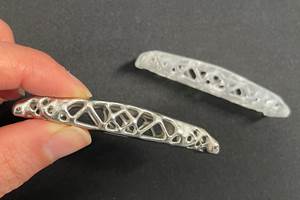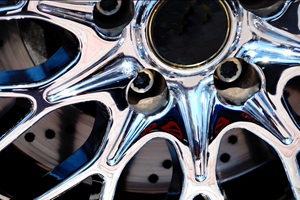Innovation in Plating on Plastic
Plating on advanced plastics solution offers improved adhesion, temperature resistance and cost savings.

This 3-D printed radar array is PAEK plated using GreenPOP activation with plated layers of copper and electroless nickel. Source (All images): Alliance Finishing and Manufacturing
“There hasn’t been a major evolution in metal finishing in over 60 years.”
Mark Hyman, president of Alliance Finishing and Manufacturing (Oxnard, California) and inventor of GreenPOP, a solution for plating on advanced plastics, has a way of getting your attention, right off the bat. He goes on to explain that much of the evolution in metal finishing involves the evolution of chemistries to address regulatory concerns or to improve esthetics.
Meanwhile, manufacturing is evolving at a rapid pace with the emergence of new materials and ways of making parts in addition to new demands on applications requiring electrical properties and connectivity.
“We are in what we call the semiconductor phase of our existence — everything we touch runs on chips,” Hyman says . “And the evolution of any technology you can think of is going to be based on the materials of its construction. I truly believe the future of metal finishing is not necessarily in metals.”
Hyman’s vision stems from a desire to leave a lasting impact on the industry, to usher in a significant improvement that would transcend the status quo of surface finishing.
Plating on plastics isn’t new. Electroplating on plastic typically involves the process of depositing a thin layer of metal onto a plastic substrate using an electrochemical process after first preparing the plastic in order for the metal to adhere. First, the substrate is subjected to processes such as degreasing, alkaline cleaning, and possibly etching to promote adhesion. Since plastics are typically non-conductive, they cannot conduct electricity required for the electroplating process. Therefore, a conductive layer must be applied to the surface of the plastic. This is often achieved through a process called activation.
Activation of a plastic substrate can involve various methods such as chemical treatment, flame treatment or plasma treatment. These methods essentially roughen the surface, creating sites for metal adhesion. Often, it is also necessary to then treat the activated surface with a chemical solution containing palladium or tin ion. Once the surface is properly prepared and activated, the plastic part can then be immersed in an electrolyte solution containing metal ions and effectively electroplated in the traditional manner: a conductive anode made of the metal is also placed in the electrolyte solution, current is applied and metal ions from the electrolyte are attracted to the surface of the plastic substrate and deposited onto it, forming a thin metal layer. The thickness and properties of the metal layer can be controlled by adjusting parameters such as current density, plating time and composition of the electrolyte solution.
Hyman, however, recognized the need for something new. Advanced plastics such as polyether ether ketone (PEEK), polyetherimide (PEI, commercially known as Ultem), polycarbonate/acrylonitrile butadiene styrene (PC-ABS), polyphenylene sulfide (PPS) and composite materials used for high performance applications require more than decorative solutions.
“So, it’s more than just plating on plastics,” Hyman says.
He set out to create a new approach to plating on plastics based on four goals: the approach should be environmentally friendly, there should be a visual indication of success, it should be waste treatable, and it would not rely on precious metals.
Hyman would spend more than nine years of research and development working on his approach to plating on plastics. His goal was to find a way to get the substrate itself to hold a charge, rather than rely on an etching process and subsequent metallization prior to plating. He also hoped to provide alternatives to traditional methods reliant on palladium activators and hexavalent chromium, as well as improve adhesion and performance, and also reduce waste and reliance on scarce resources. Ultimately, he named the chemistry GreenPOP.
Chemical vs. mechanical adhesion

An injection molded PEEK connector plated with GreenPOP and copper layers meet thermal and electrical requirements for composite connectors per MIL-DTL-3899.
GreenPOP is an adhesional pretreatment technology for plating on plastics and composites parts. It revolutionizes the traditional approach to surface coating, offering a patented innovative metallizing process. Unlike its predecessors, GreenPOP eliminates the necessity for toxic chrome-based acid etchants, abrasive blasting or organic solvents.
Based on a commitment to environmental sustainability, Hyman aptly named the chemistry GreenPOP to encompass the plating on plastics, but also identifying the chemistry as eco-friendly. In addition, GreenPOP represents a departure from the reliance on precious metals for metallization of the substrate prior to plating, making it a more cost-effective approach.

These low-noise PEEK antenna parts have copper plating and masking.
Increased adhesion and temperature resistance
GreenPOP enables the ability to employ direct electroplating methods to plastic substrates, providing improved adhesion on the primary plated layer, surpassing the results achieved through electroless metallization. This not only enhances the quality of the coated parts but also reduces production costs significantly. Moreover, GreenPOP offers unmatched thermal shock stability, meeting or exceeding the stringent requirements of MIL-DTL-38999 for composite plated connectors. The resulting parts exhibit good smoothness and dimensional stability, preserving the details and aesthetic qualities of the original plastic components. In terms of adhesion, achieving yields of up to 97% compared to 30% of previous methods.
The impact of GreenPOP could extend beyond traditional applications that employ plating on plastic. The solution is seeing use in diverse industries including aerospace, automotive and electronics. The ability to electroplate on lightweight composites and additively manufactured parts opens new avenues for innovation, making plating on plastic an option for enhancing functionality of parts in addition to providing esthetics.
Related Content
Possibilities From Electroplating 3D Printed Plastic Parts
Adding layers of nickel or copper to 3D printed polymer can impart desired properties such as electrical conductivity, EMI shielding, abrasion resistance and improved strength — approaching and even exceeding 3D printed metal, according to RePliForm.
Read MoreA Chromium Plating Overview
An overview of decorative and hard chromium electroplating processes.
Read MoreIn-House Blackening of Ferrous and Non-Ferrous Metals
Process satisfies customers’ shipping requirements while meeting stricter water regulations in times of drought.
Read MoreFilter Press Troubleshooting and Optimization
Zachary Beckman of Haviland Enterprises Inc. discusses proper filter press maintenance for optimization of wastewater treatment systems.
Read MoreRead Next
Plating Additively Manufactured Plastic Parts
Using electroplating to enhance the structural properties of 3D printed parts.
Read MorePossibilities From Electroplating 3D Printed Plastic Parts
Adding layers of nickel or copper to 3D printed polymer can impart desired properties such as electrical conductivity, EMI shielding, abrasion resistance and improved strength — approaching and even exceeding 3D printed metal, according to RePliForm.
Read MorePowder Coating 4.0: Smarter, Faster, More Efficient and Connected
New tools reduce cost and waste, lower manufacturing footprint of powder coating operations.
Read More


























